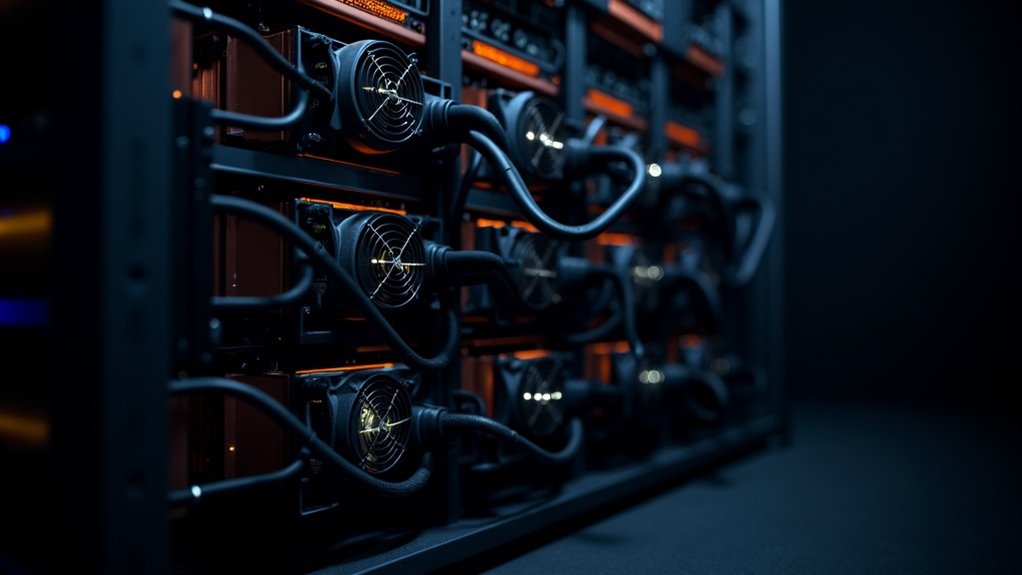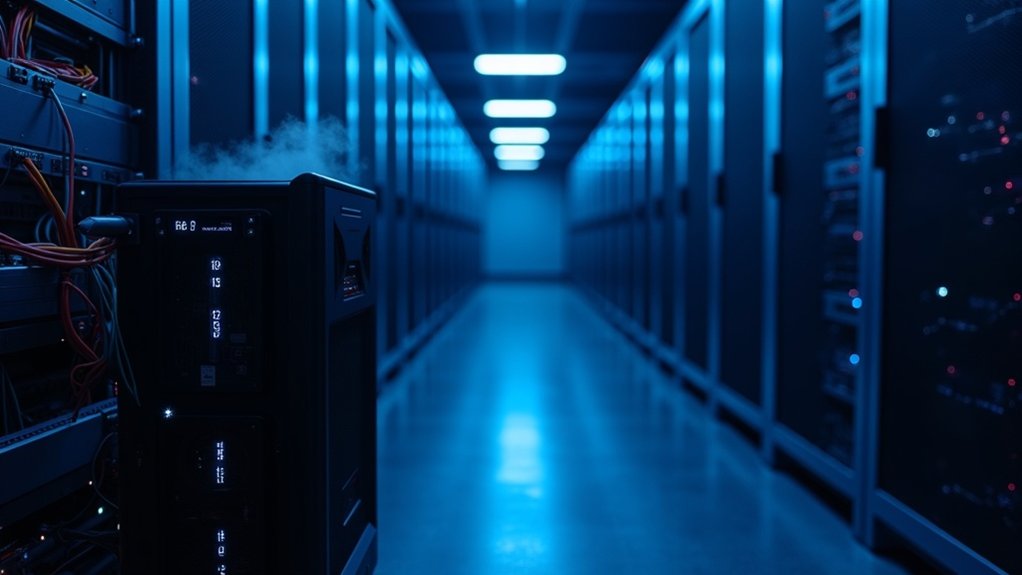Running a mining node requires serious hardware: 8-core processor, 8GB RAM, and 600GB storage. You’ll need Bitcoin Core software, steady internet, and patience for days-long blockchain synchronization. ASIC mining hardware demands careful power management and proper firmware updates. Ethernet connections beat WiFi for stability. Port forwarding must be configured for network communication. The process tests commitment—constant 24/7 operation is non-negotiable. The technical journey separates casual enthusiasts from dedicated miners.
Running a mining node isn’t for the faint of heart. It demands serious hardware, software smarts, and patience. Lots of patience. The minimum setup requires a dual-core 64-bit processor, though serious miners opt for 8 cores. You’ll need at least 2 GB of RAM, but 8 GB keeps things running smoothly. Storage? Better have 600+ GB ready for that massive blockchain. Running a full node enhances network security by independently validating all transactions. These systems help maintain integrity by solving cryptographic puzzles that secure the network.
Bitcoin mining: where patience meets processing power in the digital gold rush
And forget spotty internet—you need steady broadband with decent upload speeds. Your ISP might hate you for the 200+ GB monthly data usage. Just saying.
Getting the software right matters. Download Bitcoin Core or another compatible program like Bitcoin Knots. Choose between pretty GUI interfaces or command-line operations, depending on whether you like clicking buttons or typing like a hacker. Keep that software updated. Security matters.
The initial blockchain sync takes forever—days, not hours. It’s over 585 GB now and growing. It’s essential to complete this Initial Block Download process before your node can fully participate in the network. Turn off those sleep modes. Your node needs to stay awake 24/7.
Network setup is vital. Ditch the WiFi. Ethernet cables are your friend here. Set up port forwarding on your router—yes, you’ll need to figure that out. Your node needs to talk to the network properly. Monitor that bandwidth usage or prepare for a nasty surprise on your next internet bill.
When connecting mining hardware, be careful with power requirements. ASICs are picky. Check for damage before plugging anything in. Update firmware first, then connect via Ethernet for minimal latency. Configure your mining software with the right pool details or solo settings.
Initial synchronization is the real test of commitment. Days of downloading. Every block verified. Every transaction checked. The blockchain doesn’t care about your impatience. But once you’re synced, you’re part of something bigger—the backbone of cryptocurrency.
Whether it’s worth the electric bill? That’s another question entirely.
Frequently Asked Questions
What Is the Minimum Internet Speed Required for Mining?
Minimum internet speeds vary by mining type. ASIC miners need 10-20 Mbps, while GPU rigs require at least 100 Mbps.
It’s not just about speed though. Stability matters more. Latency should stay under 70 milliseconds. Wired connections beat Wi-Fi every time.
Funny how people obsess over gigabit internet when mining uses minimal data—just 100-200 MB monthly per machine. The real priority? Consistent, low-latency connections. No interruptions, no excuses.
Can I Mine on a Laptop or Mobile Device?
Yes, technically you can mine on laptops or mobiles. But why would you?
These devices simply aren’t built for it. Laptops overheat, suffer battery degradation, and have weak processing power compared to dedicated rigs.
Mining mainstream cryptocurrencies? Forget it. Some smaller coins might be somewhat feasible, but profits? Laughable.
The hardware damage risks far outweigh the minimal rewards. Your expensive laptop will basically cook itself for pennies. Not exactly a brilliant investment strategy.
How Much Profit Can I Expect From Mining?
Profit from mining? Wildly variable. Depends on multiple factors – Bitcoin price, electricity costs, your hardware, and network difficulty.
Current metrics show $57,400 daily revenue per EH/s. But that’s network-wide.
Individual miners face tough math. ROI could exceed 50% annually if Bitcoin hits $200K. Below $50K? You’re probably losing money.
Large operations with cheap electricity make it work.
Small miners? Not so much.
Mining economics aren’t what they used to be. Simple as that.
Are There Tax Implications for Cryptocurrency Mining Earnings?
Yes. Massive tax implications. Mining rewards count as income—taxed at 10-37% when received.
Then there’s the double-whammy: sell those coins later? Capital gains tax kicks in too.
Business miners can deduct expenses; hobby miners mostly can’t.
Self-employed? Tack on that Self Employment Tax for Medicare and Social Security.
Starting 2025, reporting gets stricter with exchanges issuing 1099-DAs.
The IRS isn’t messing around with crypto anymore.
How Do Mining Pools Distribute Rewards Among Participants?
Mining pools distribute rewards using various systems.
PPS pays fixed amounts per share submitted—predictable, but pools charge higher fees.
PROP rewards miners proportionally when a block is found—no block, no pay.
PPLNS considers contributions over multiple blocks, rewarding loyalty and discouraging pool-hopping.
FPPS includes transaction fees on top of block rewards.
Each system shifts risk differently between miners and pool operators.
The choice? Depends on whether miners prefer stability or potential higher payouts.
Luck plays a role too.









